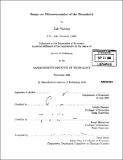| dc.contributor.advisor | Abhijit Banerjee and Bengt Holmstrom. | en_US |
| dc.contributor.author | Wahhaj, Zaki | en_US |
| dc.contributor.other | Massachusetts Institute of Technology. Dept. of Economics. | en_US |
| dc.date.accessioned | 2007-05-16T18:32:10Z | |
| dc.date.available | 2007-05-16T18:32:10Z | |
| dc.date.copyright | 2006 | en_US |
| dc.date.issued | 2006 | en_US |
| dc.identifier.uri | http://hdl.handle.net/1721.1/37405 | |
| dc.description | Thesis (Ph. D.)--Massachusetts Institute of Technology, Dept. of Economics, 2006. | en_US |
| dc.description | Includes bibliographical references. | en_US |
| dc.description.abstract | These essays are concerned with the problem of cooperation among individuals in a household and among households in a community under lack of commitment. The first chapter provides a theoretical investigation of consumption patterns in a household in which income is stochastic and some expenditures are public to household members. It is shown that in the constrained efficient agreement, private expenditures of household members do not necessarily co-move, as they do in both the first-best agreement and the constrained efficient agreement when all expenditures are private. In particular, the absence of co-movement of private expenditures in the household do not necessarily imply the absence of mutual insurance; and, indeed, negative correlation in private expenditures can be consistent with a cooperative agreement. These results indicate that caution should be used in interpreting the correlation of private expenditures of household members as a measure of cooperation and mutual insurance within the household. Chapter two investigates the effect of lack of commitment on household savings in a constrained efficient mutual insurance agreement among different households. | en_US |
| dc.description.abstract | (cont.) It is shown that a saving rule is part of the agreement if and only if risk aversion changes with wealth. If not, no gains can be had from contracting on savings. Under reasonable assumptions about risk preferences, the constrained efficient agreement tends to depress savings to a greater extent for poorer individuals than for richer individuals, thus increasing inequality in consumption and wealth over time relative to the case where savings are not contracted. Chapter three (co-authored with Harounan Kazianga) provides evidence, using a survey of agricultural households in Burkina Faso, that plots owned by the head of the household is farmed much more intensively than plots, with similar characteristics and planted to the same crops, owned by other household members (of both genders). As in previous studies, this evidence is inconsistent with the assumption of Pareto efficiency in household decisions, but additionally suggests that status within the household rather than gender per se may be the most important factor in determining the allocation of productive resources within the household. We argue that the higher yields achieved by the household head may be explained in terms of social norms that require him to spend the earnings from some farms under his control exclusively on household public goods, as has been observed in the anthropological literature on this region. | en_US |
| dc.description.statementofresponsibility | by Zaki Wahhaj. | en_US |
| dc.format.extent | 76, [6] leaves | en_US |
| dc.language.iso | eng | en_US |
| dc.publisher | Massachusetts Institute of Technology | en_US |
| dc.rights | M.I.T. theses are protected by copyright. They may be viewed from this source for any purpose, but reproduction or distribution in any format is prohibited without written permission. See provided URL for inquiries about permission. | en_US |
| dc.rights.uri | http://dspace.mit.edu/handle/1721.1/7582 | |
| dc.subject | Economics. | en_US |
| dc.title | Essays on microeconomics of the household | en_US |
| dc.type | Thesis | en_US |
| dc.description.degree | Ph.D. | en_US |
| dc.contributor.department | Massachusetts Institute of Technology. Department of Economics | |
| dc.identifier.oclc | 123025076 | en_US |
